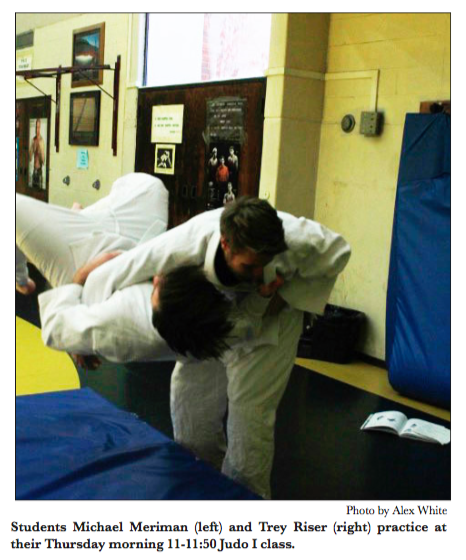Meramec offers PE classes in martial arts for credit
By: KATIE HAYES
Copy Editor
Meramec offers classes in two forms of martial arts — karate and judo. Personal Defense is offered as well, which incorporates martial arts. These subjects are all taught by Ron Mirikitani, who has been teaching these classes at Meramec since the 1970’s.
“It’s a safe sport in that once you get to a certain point and there’s a possibility of injury, the person just has to tap twice — that means they give up and they stop the match and the other person wins,” Mirikitani said.
person wins,” Mirikitani said.
Although judo and karate are both of Japanese origins, they differ in style.
“Karate is more striking and kicking and blocking, where judo is more throwing, holding, choking and arm bars,” Mirikitani said. “They’re trying to throw you and they’re trying to either ground you or break your arms [to get the person to tap out], so that’s pretty aggressive. In karate, they’re either trying to strike you or kick you.”
At the beginning of each semester, Mirikitani asks stu- dents to write why they are taking the class and what they hope to learn. Although he doesn’t verbally address these aspirations, he makes sure each student gets to practice what they want.
“I had one class, probably about five years ago, where just about everybody in class had some kind of confrontation,” Mirikitani said. “So they were really, really zeroing in on this class that I taught. No one missed a class and it was just awesome.”
When asked about using martial arts techniques on the street, Mirikitani didn’t oppose it.
“Any time you’re attacked on the street, I think you have an obligation to protect yourself and use whatever means you can find,” Mirikitani said.
Sammy Schoonover, who has been at Meramec since 2013 and never taken a martial arts course, took Judo I this fall.
“Now I know somewhat how to defend myself,” Schoonover said. “I like flipping people.”
Jenita Checkett took Judo I this fall as well, but previously took other martial arts courses.
“I like the people and the thrills — throwing people. It’s fun.” Checkett said.
Currently, Judo II is the highest level judo course offered at Meramec.
“Right now, it’s hard to get people in Judo II class because it’s only offered once in the semester at a certain time and a certain day,” Mirikitani said. “So for people to find that time in their schedule is sometimes hard to find. I have some people who wanted to get in the class but they had other obligations and couldn’t get in there.”
It is possible, however, to advance in judo at Meramec after taking Judo II.
“If a person is really interested in getting more technical and more advanced in judo, I would tell them to take Judo II again,” Mirikitani said.
In Judo I, students learn five throws, hit techniques, hand techniques, a foot technique, two or three holding techniques, five or six choking techniques and five or six arm block techniques, Mirikitani said.
However, students don’t typically get a belt after their first class. Judo II teaches more throws and and students work on combinations. They get more into throws and more advanced mat techniques, transitions and more competi- tion techniques. While students could test for a belt if they wanted, most don’t, Mirikitani said.
Most students don’t plan to obtain a professional ranking specifically in judo, but use it to improve in other forms of martial arts.
“Most [students] aren’t interested in getting a ranking — they’re in there just to learn,” Mirikitani said. “I have a lot of people who are in there now who are going into MMA and they want to learn jujitsu, so I teach a lot of mat techniques, arm bars and chokes.”
In addition, some students simply want to learn a new skill.
“A lot of people come in just because they’ve always wanted to study judo and they thought that this is a cheap way to learn,” Mirikitani said. “A lot of people have had a brother or sister or friend take a class and they thought it was fun so they want to take a class too.”
Mirikitani expressed that although he mostly sees college-aged students in his classes, he does get students of all ages and backgrounds.
“They come in with dif- ferent motives and different aspirations,” Mirikitani said.










